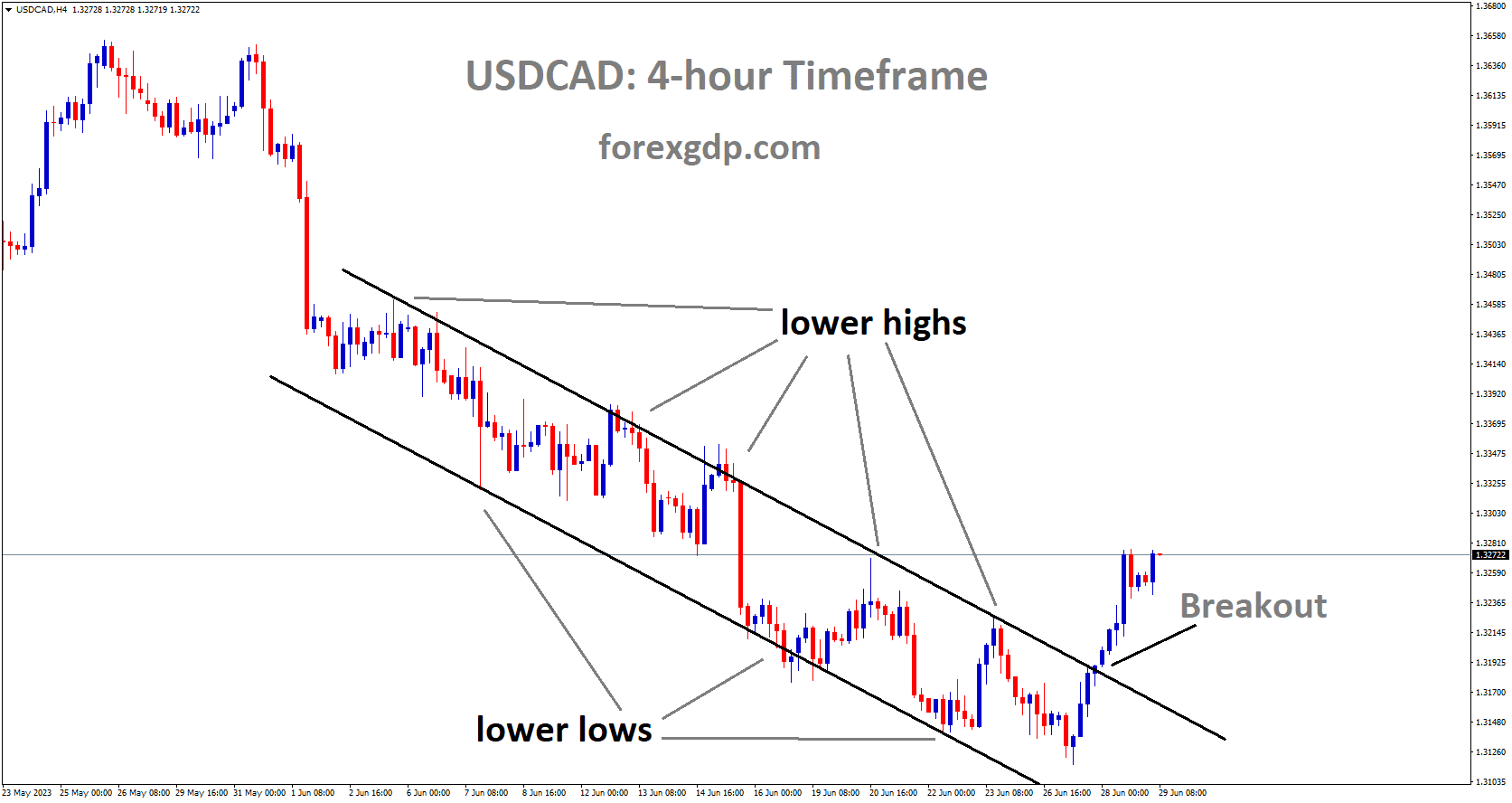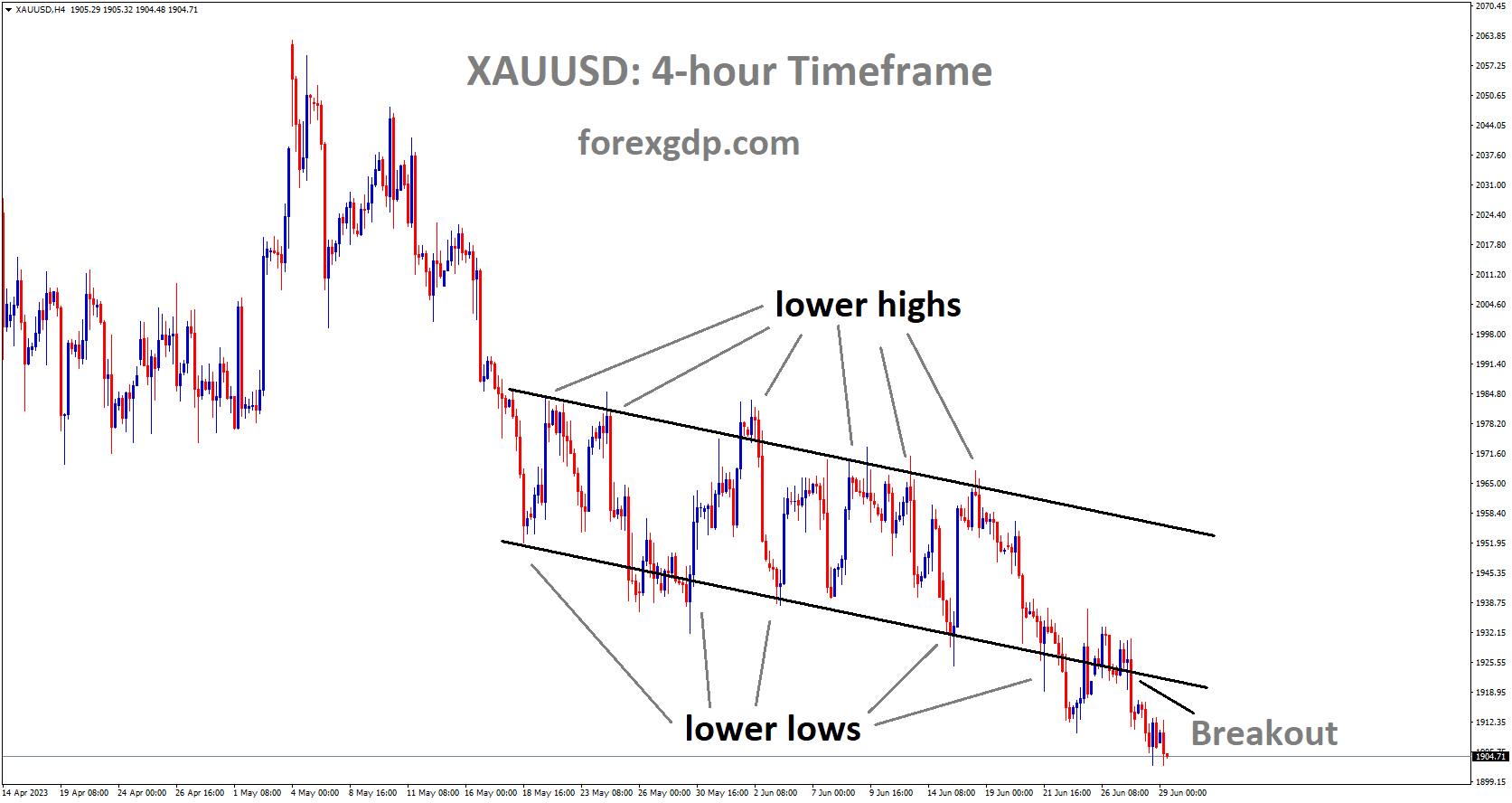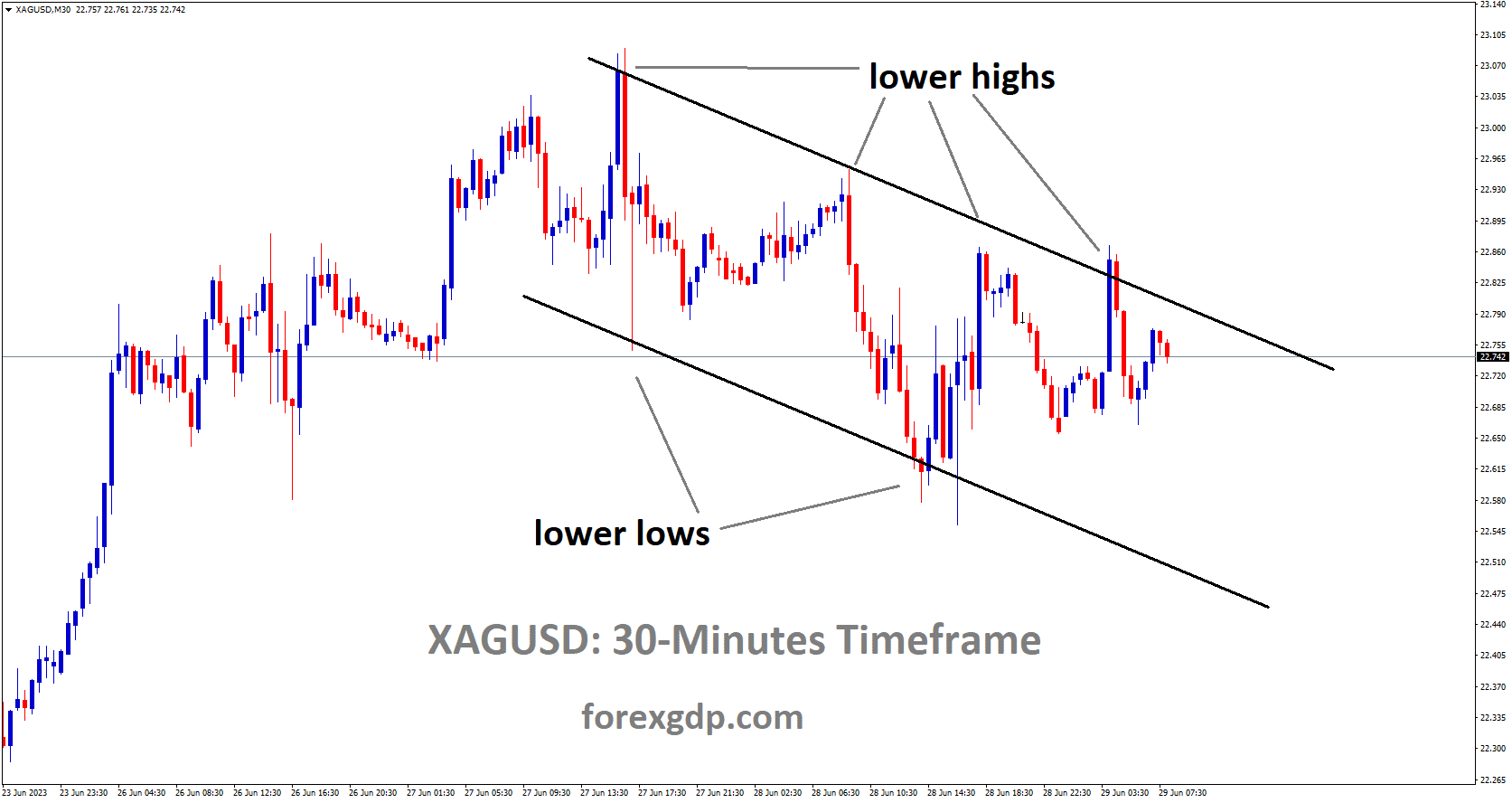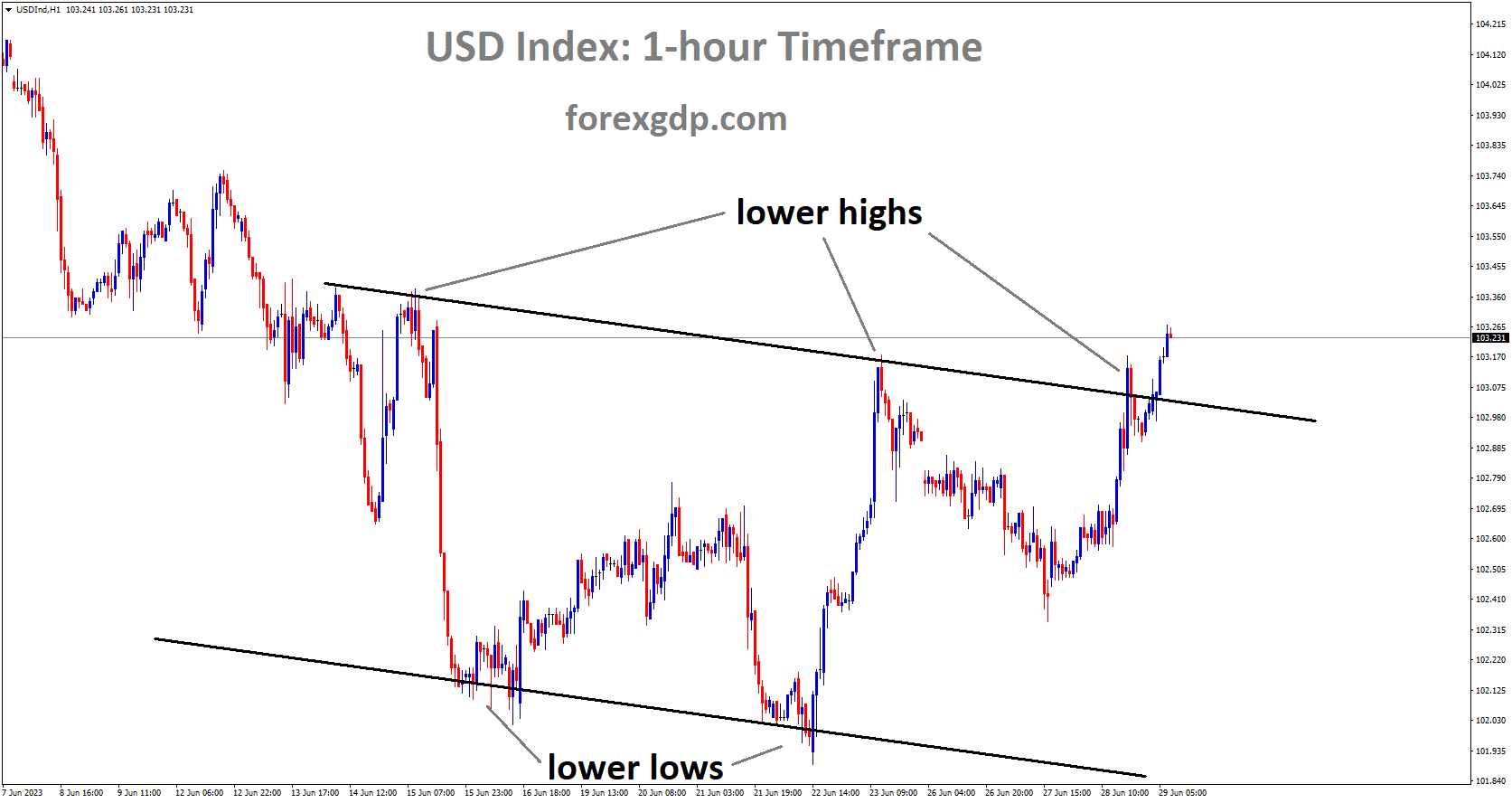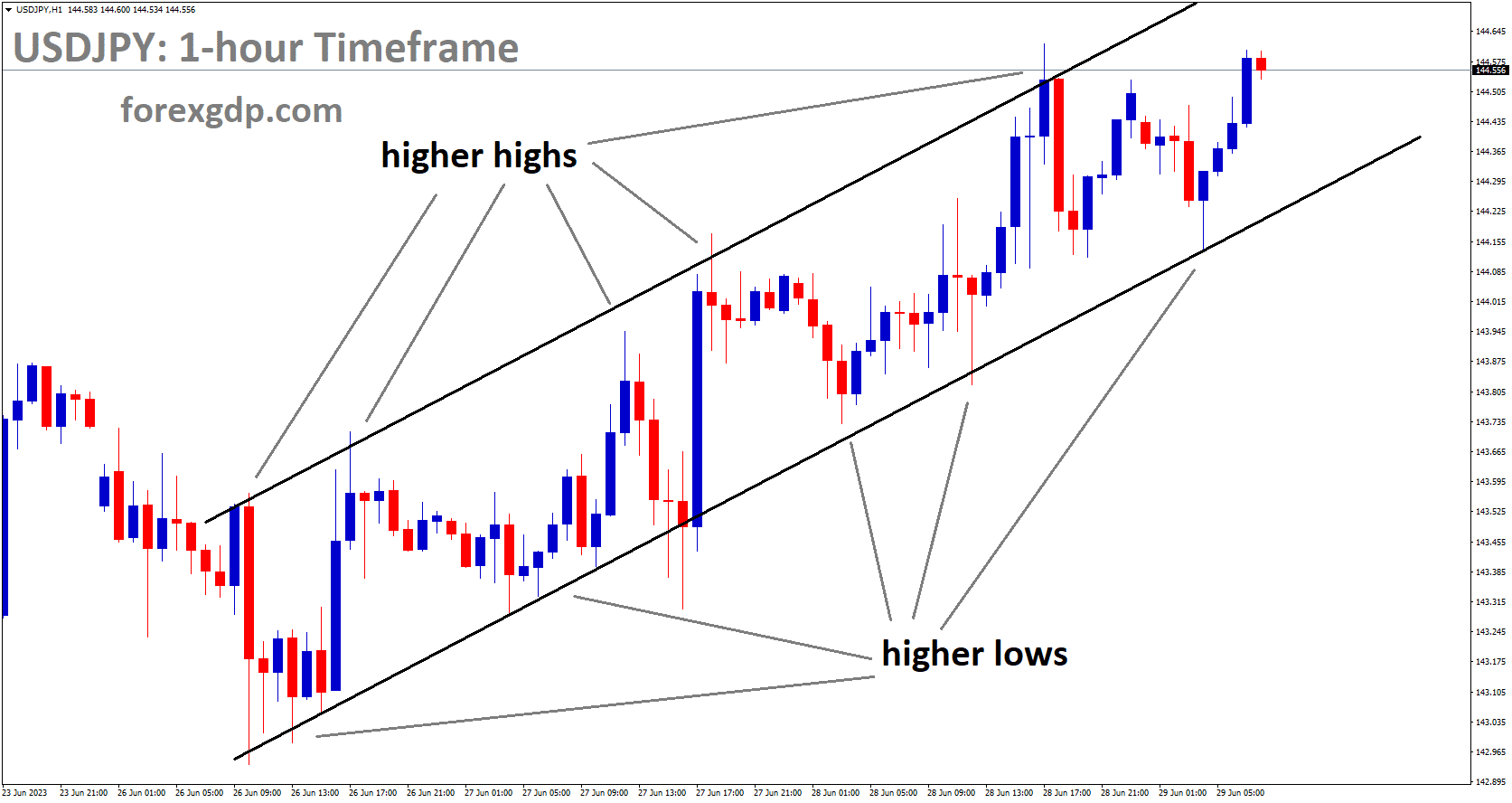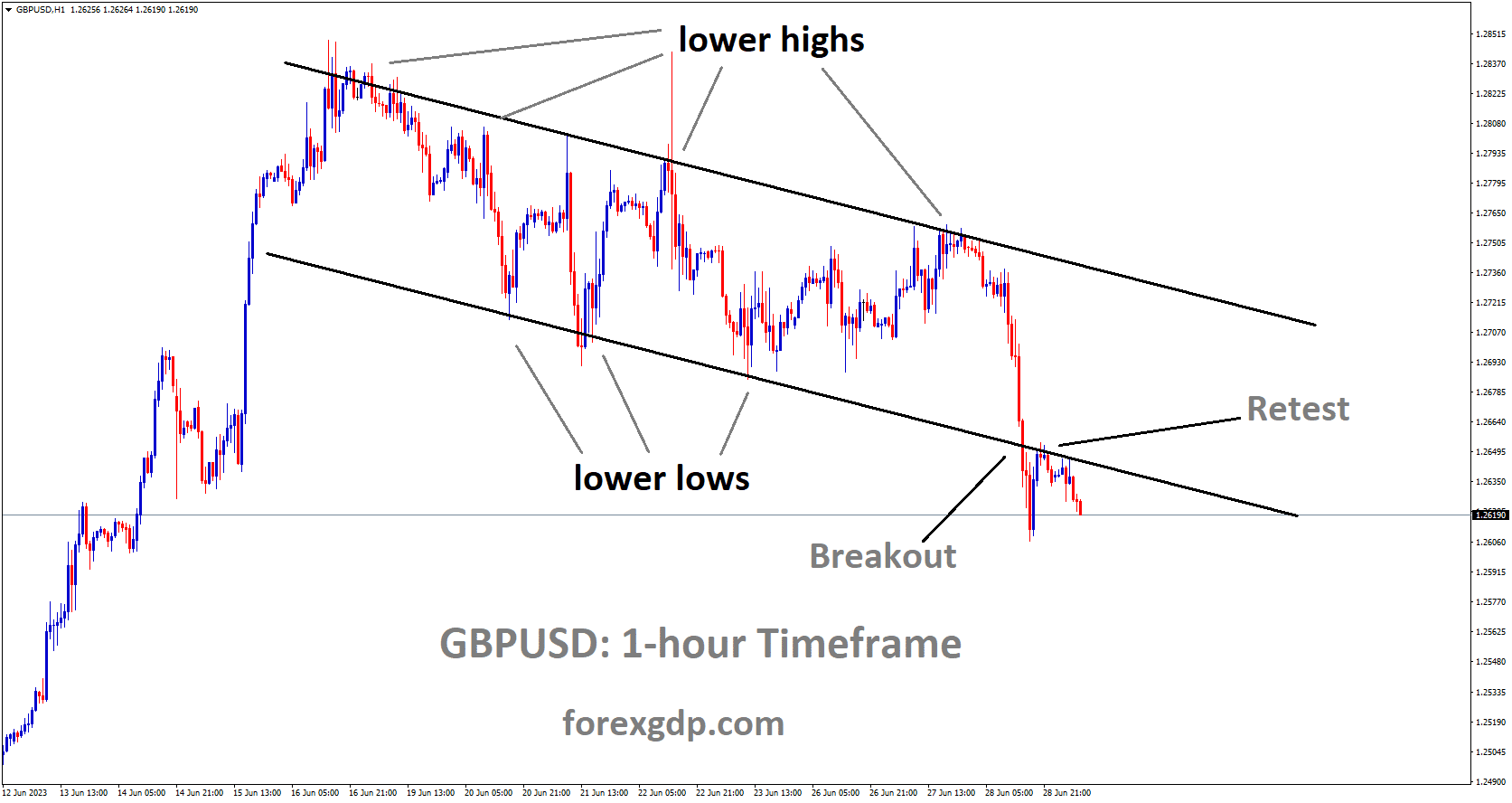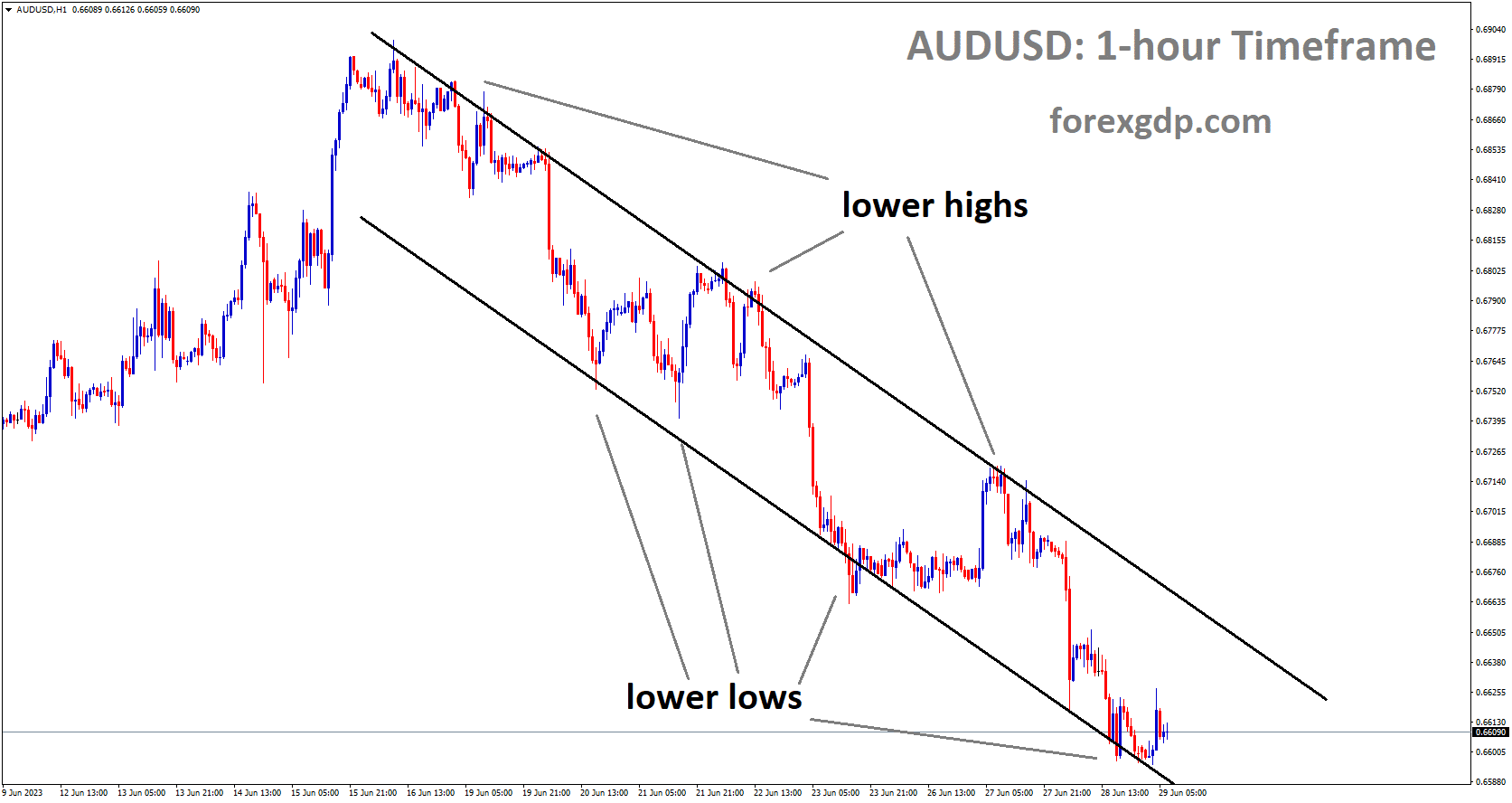USDCAD is moving in descending channel and the market has broken at the lower high area of the channel.
The US GDP is expected to increase as a result of the decision to pause rate hikes this month. It is unlikely that a US recession will occur this year since no rate cuts are anticipated. However, it is possible that the GDP growth may slow gradually throughout the year.
In the ever-changing landscape of the global economy, staying informed about key economic releases is crucial for traders, investors, and analysts. These releases provide valuable insights into the state of the economy and can significantly impact the course of financial markets. This article delves into the upcoming economic releases scheduled for this week, including the US Personal Consumption Expenditures (PCE), US Q1 GDP, Eurozone preliminary inflation data, and China’s June PMI. The analysis explores the potential implications of these releases on monetary policies, market sentiments, and specific currency pairs.
US Personal Consumption Expenditures (PCE): A Guide to Interest Rate Hikes
1.1 Understanding the Importance of PCE
The US Personal Consumption Expenditures (PCE) data, reported by the Bureau of Economic Analysis, measures the spending habits of US citizens on goods and certain services. It is an important indicator of consumer spending, which drives a significant portion of the US economy. Higher PCE levels indicate increased consumer spending, while lower levels may suggest a decline in consumer demand.
1.2 The Federal Reserve’s Use of PCE as an Inflation Gauge
The Federal Reserve closely monitors the PCE data as it serves as one of its preferred measures of inflation.
XAUUSD Gold is moving in descending channel pattern and the market has broken at the lower low area of the channel.
The central bank uses this data in its decision-making process, particularly in determining its interest rate policies. Higher PCE levels can indicate rising inflationary pressures, which may prompt the Federal Reserve to consider tightening monetary policy through interest rate hikes.
1.3 Impact of PCE on the US Economy and Monetary Policy
The release of the PCE data can significantly impact the US economy and financial markets. Traders and analysts closely watch this data to gain insights into consumer spending patterns and assess the overall health of the economy. Additionally, the PCE data can provide guidance regarding potential interest rate hikes by the Federal Reserve, influencing market sentiments and the value of the US dollar.
US Q1 GDP: A Crucial Indicator for the Economy’s Trajectory

2.1 Assessing the Current State of the US Economy
The US Q1 GDP data provides a comprehensive overview of the country’s economic performance during the first quarter of the year. It measures the total value of goods and services produced within the US, reflecting the overall economic activity. Analysts and policymakers analyze this data to evaluate the growth rate and identify key sectors driving or hindering economic expansion.
2.2 Potential Impact of Q1 GDP on Market Sentiments
The Q1 GDP release can have a significant impact on market sentiments and investor confidence. A higher-than-expected GDP growth rate indicates a robust economy, which can boost market optimism and drive stock prices higher.
XAGUSD Silver is moving in descending channel pattern and the market has reached the lower high area of the channel.
Conversely, a lower-than-expected GDP growth rate may raise concerns about economic slowdown and potentially lead to a decline in market performance.
2.3 Implications for the Federal Reserve’s Policies
The Q1 GDP data can influence the Federal Reserve’s monetary policy decisions. A strong GDP growth rate may suggest a need for tighter monetary policy to prevent overheating and rising inflation. Conversely, a weak GDP growth rate may prompt the central bank to consider maintaining accommodative policies or even implementing stimulus measures to support economic recovery.
Eurozone Preliminary Inflation Data: Influencing the ECB’s Monetary Policy

3.1 Significance of Eurozone Inflation Data
Inflation data is a crucial indicator of price stability and economic health within the Eurozone. The Eurozone preliminary inflation data provides insights into the rate at which consumer prices are rising or falling. It is closely monitored by market participants as it influences the European Central Bank’s (ECB) monetary policy decisions.
3.2 Assessing the ECB’s Stance on Interest Rate Hikes
The ECB closely monitors inflation data to determine its monetary policy approach. While headline inflation is expected to show a slight easing in the Euro Area, underlying inflation remains a concern for the central bank.
USD Index is moving in descending channel and the market has reached lower high area of the channel.
The ECB has expressed a hawkish approach, suggesting that interest rate hikes may be necessary to control inflation and bring it in line with the target of 2%.
3.3 Impact of Inflation Data on the Euro and Forex Market
The release of Eurozone inflation data can significantly impact the value of the euro and the foreign exchange (Forex) market. In general, higher interest rates can increase the purchasing power of the euro, making it more attractive to investors. Therefore, if inflation data suggests a need for interest rate hikes, the euro may strengthen against other currencies. Conversely, weaker-than-expected inflation data may lead to a depreciation of the euro.
China’s June PMI: Gauging the Health of the World’s Second-Largest Economy

4.1 Recent Weakness in the Chinese Economy
China plays a pivotal role in the global economy, and its economic performance has a significant impact on global markets. Recent economic data releases have indicated weaknesses in the Chinese economy, such as a slump in the property market and a decline in retail sales. These factors have raised concerns about deflationary pressures and the overall health of the Chinese economy.
4.2 The Role of PMI in Assessing Economic Performance
The Purchasing Managers’ Index (PMI) is a widely recognized indicator that provides insights into the health of the manufacturing and services sectors.
USDJPY is moving in a ascending channel and the market has rebounded from the higher higher low of the pattern.
The release of China’s June PMI data allows analysts to gauge the country’s economic performance, with readings above 50 indicating expansion and readings below 50 suggesting contraction.
4.3 Potential Implications for Global Markets
China’s economic performance has far-reaching implications for global markets, given its status as the world’s second-largest economy.Weaker economic data from China can negatively impact investor sentiment, particularly in sectors with significant exposure to the Chinese market. It can also influence commodity prices, supply chains, and trade dynamics, affecting global market trends.
HSBC Asset Management’s Outlook: Recession Warnings and Monetary Policies
5.1 HSBC’s Midyear Outlook on the Global Economy
HSBC Asset Management has provided insights into the global economy, warning of potential recessions and highlighting the misalignment between fiscal and monetary policies with stock and bond markets. The institution emphasizes the need for coordinated efforts to address the challenges faced by many economies.
5.2 The Importance of Inflation Control and Interest Rate Cuts
HSBC Asset Management emphasizes the importance of controlling inflation and implementing interest rate cuts to mitigate the risks of recession.
GBPUSD has broken the descending channel and retested the lower low area of channel.
The institution expects central banks, such as the US Federal Reserve, the European Central Bank, and the Bank of England, to reduce interest rates in response to economic challenges.
5.3 Assessing the Impact on Stock and Bond Markets
The recession warnings and potential monetary policy actions outlined by HSBC Asset Management can significantly impact stock and bond markets. Market participants closely monitor these predictions to adjust their investment strategies and manage their portfolios effectively. The actions of central banks and their impact on interest rates can influence market sentiments and asset valuations.
Bank for International Settlements’ Call for More Interest Rate Hikes
6.1 The BIS’s Warning on Inflation and the World Economy
The Bank for International Settlements (BIS) has highlighted the need for more interest rate hikes to address inflationary pressures and ensure price stability in the global economy. The BIS warns that inflation remains high in many major economies, and fiscal and monetary policies must align with stock and bond markets.
6.2 Challenges Faced by Central Banks and Policymakers
The BIS recognizes the challenges faced by central banks and policymakers as they navigate a complex economic landscape.
AUDUSD is moving in descending channel and the market has reached the lower low area of the channel.
Rising inflation and financial vulnerabilities pose risks to the banking sector, and the BIS emphasizes the importance of appropriate policy responses to mitigate these risks effectively.
6.3 Potential Consequences and Strategies for Mitigation
The BIS warns that failing to address inflation could lead to further problems in the banking sector and jeopardize economic stability. It suggests that central banks may need to navigate the difficult path of interest rate hikes to control inflation effectively. However, the cost and potential consequences of these actions must be carefully considered.
The Future of Central Banking and Evolving Financial Systems
7.1 Navigating the Last Mile: Overcoming Challenges in Interest Rate Rises
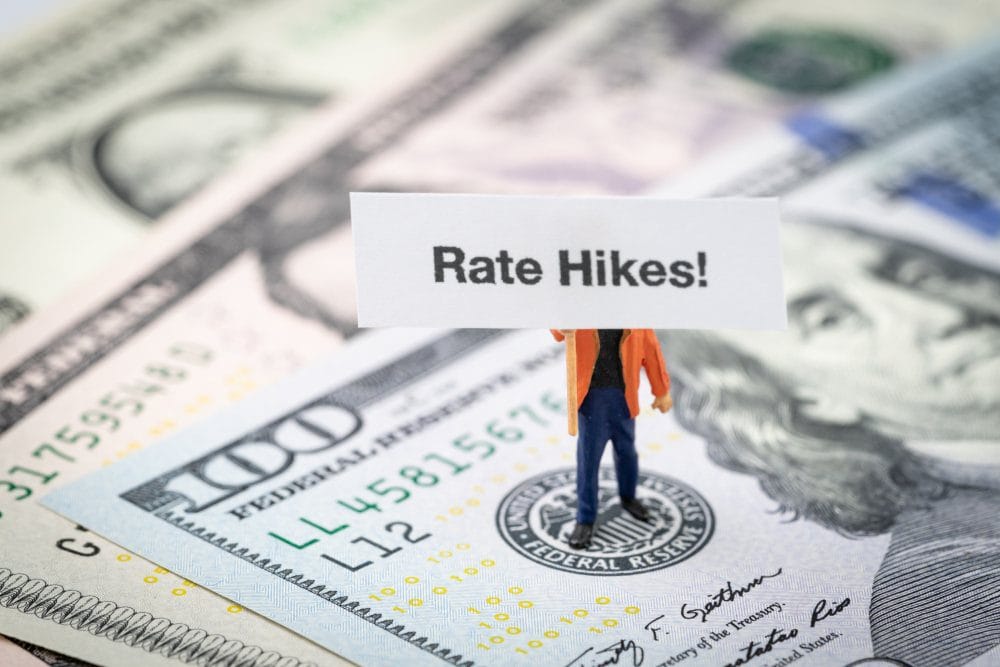
As central banks aim to rein in inflation and restore price stability, the BIS acknowledges the challenges they face in managing interest rate rises. Balancing the need for tighter monetary policy without triggering recessions or major banking crises requires careful navigation and consideration of economic conditions.
7.2 Shifting Economic Expectations and the Need for Corrective Measures
Central banks and policymakers must adjust economic expectations and correct unrealistic notions of perpetual monetary and fiscal support.The BIS emphasizes the need for corrective measures to ensure long-term economic stability and price stability.
7.3 The Role of Central Bank Digital Currencies and Tokenized Assets
The BIS highlights the evolving nature of financial systems and suggests the adoption of central bank digital currencies (CBDCs) and tokenized assets. These technological advancements can enhance transaction speed, efficiency, and transparency, revolutionizing global trade and financial transactions.
Conclusion
The analysis of key economic releases, including the US PCE, Q1 GDP, Eurozone inflation data, and China’s PMI, provides crucial insights into the state of the global economy and its impact on financial markets. Monitoring these indicators allows traders, investors, and policymakers to make informed decisions and adjust their strategies accordingly. Additionally, the outlooks presented by institutions like HSBC Asset Management and the Bank for International Settlements offer valuable perspectives on potential risks, monetary policies, and the future of central banking. By staying informed and analyzing these economic releases, market participants can navigate the dynamic financial landscape and optimize their investment decisions.
Don’t trade all the time, trade forex only at the confirmed trade setups.
Get Live Free Signals now: forexgdp.com/forex-signals/

